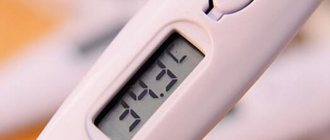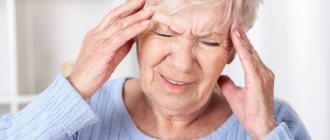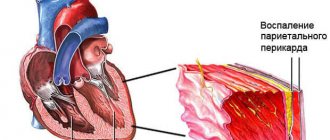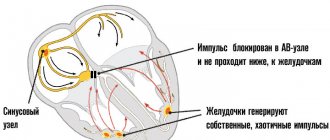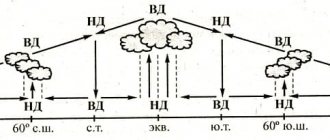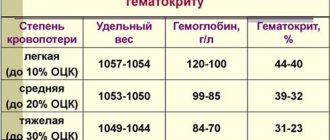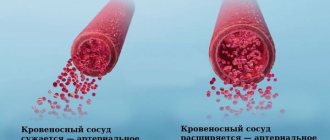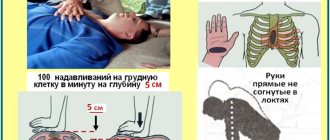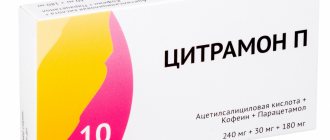The norm is considered to be a general body temperature of +36 to +37°C. A periodic decrease to +35.5°C is possible with hypotension, hypothermia and some infections. Usually this condition normalizes on its own over time. But there are situations where hypothermia is very dangerous.
Nervous and physical exhaustion
High physical activity, prolonged stress, lack of sleep, poor diet and strict diets often lead to a deficiency of the body’s energy resources. As a result: metabolism slows down, blood circulation slows down and the temperature drops below normal by 1-2 degrees. The pathological condition is accompanied by significant weight loss, apathy, weakness, fatigue, depressed mood or increased nervous excitability. There may be frequent headaches and decreased mental abilities. The person becomes distracted and inhibited. There is a weakened immune system and hypovitaminosis.
With physical and nervous exhaustion, body temperature steadily decreases to +35–35.5°C. The condition is accompanied by chills even in warm weather. This pathology is usually not life-threatening, but it is an alarming sign that requires urgent lifestyle changes.
Causes of low temperature
- Exacerbation of chronic diseases, for example, vegetative-vascular dystonia.
- Insufficient production of thyroid hormones – hypothyroidism.
- Pathologies of the adrenal glands.
- Pregnancy.
- Taking certain medications, especially antipyretics and vasoconstrictors.
- Low blood pressure, heart disease.
- General fatigue, poor sleep, depression, stress.
- Recent viral or bacterial infections.
- Anemia.
- Fasting and strict diets that caused a lack of vitamins and nutrients.
- Sepsis.
- Skin diseases affecting large areas of the body.
- Poisoning with alcohol and drugs.
- Presence of HIV infection.
There are also external reasons for a decrease in body temperature - a long stay in water, in the wind, in a cold room with drafts, staying in the same position.
Post-viral syndrome
In this case, the body temperature usually stays around +35.5°C or +35°C for several days. In the fight against infections, the body spends a lot of internal resources, suffers from the consequences of intoxication and microbial aggression, which is why many functions, including thermoregulation, are disrupted. The early period of recovery is often accompanied by a decrease in temperature. The condition is accompanied by other symptoms: physical weakness, bad mood, drowsiness, decreased concentration. Shortness of breath may occur, worsening with exertion and stress. Children, adolescents, and people with chronic vascular and central nervous system diseases are susceptible to pathology.
How can hypothermia manifest?
It is necessary to measure your temperature if you notice the following symptoms:
- increased fatigue and drowsiness, which is difficult to cope with on your own;
- feeling overwhelmed;
- nervousness, irritability;
- you find it difficult to concentrate.
Children with low body temperature experience tearfulness, lethargy, moodiness, and lack of appetite.
Do not forget that the objectivity of the thermometer readings largely depends on the time of day, age and even the location of measurement. For example, in the morning, after sleep and long rest, body temperature is always slightly lower than usual.
Low blood glucose
Hypoglycemia due to prolonged hunger and excess insulin provokes energy starvation of the brain, slows blood circulation and metabolism. As a result of glucose deficiency, physical weakness develops, dizziness, and attacks of hunger. With a prolonged lack of sugar in the blood, coordination of movements is impaired, asthenia sets in, the body breaks out in cold sweat, and body temperature drops to +35°C. In the absence of outside help to the body, fainting and hypoglycemic coma are possible. People of any age are susceptible to pathology; insulin-dependent patients suffer more often than others.
Prevention of low body temperature
- If you have chronic diseases, carefully monitor your well-being. Visit your doctor regularly and follow all his instructions.
- Strengthen your immune system. Eat a balanced diet and take a course of vitamins at least twice a year – in autumn and spring.
- When relaxing on the sea or river, do not stay in the water for too long. When you go ashore, immediately dry yourself with a towel. Small children should be changed into dry clothes immediately.
- Do not create drafts in the apartment. 10-15 minutes for ventilation is enough.
- Always dress appropriately for the weather. Don't be outside in wet clothes.
- If, due to circumstances, you are forced to spend a lot of time in the same position, give yourself five-minute exercise sessions at least once every two hours.
Help with hypothermia
Immediate measures: exposure to heat, elimination of hunger, neutralization of toxins. A person with hypothermia is advised to drink hot tea, take a bath, and wrap himself in a thick blanket. In critical conditions, hospitalization is required.
The exact causes of the pathological symptom are determined by the therapist or doctors of other profiles. Diagnostics includes biochemical and hormonal blood tests, ECG, ultrasound of internal organs, computed tomography or MRI of the spine and brain. A complete medical examination helps to identify the most unexpected causes of low temperature.
Drug therapy depends on the established diagnosis. These can be antibiotics, immunomodulators, antidepressants, nootropics. To consolidate the results of treatment, the doctor usually recommends purchasing vitamin and mineral complexes.
When is urgent medical attention needed?
- The thermometer shows 35°C, and the temperature continues to fall.
- A decrease in temperature is accompanied by bleeding, vomiting, speech and vision disturbances, loss of consciousness, hallucinations, severe yellowing of the skin and whites of the eyes.
- The temperature is reduced in a child or an elderly person and is combined with general poor health.
- There are signs of hypothermia: pale skin, bluish nasolabial triangle, chills, shortness of breath, rapid pulse, lethargy.
- Low temperature is especially dangerous for elderly and seriously ill people.
What not to do at high temperatures
You should react to an elevated temperature without panic, but with special care.
It is not recommended to bring it down in the first minutes after the increase; you need to let the body cope with the temperature on its own. At this time, the body’s defenses are mobilized and pathogens of various diseases die. But even when lowering the temperature, you should not strive for 36.6. In the first days of illness, this is unlikely to be achieved. Rubbing, especially with vinegar or alcohol solutions, is not recommended. However, this practice still exists at home. If a patient with a high fever is pale and his limbs are cold to the touch (so-called white hyperthermia), then any rubbing is contraindicated for him and, in addition to antipyretics, antispasmodics are recommended. The fact is that cold extremities are caused by vasospasm. And in this case, cold rubbing with vinegar or alcohol-containing liquids can only worsen the situation with the blood vessels.
Wiping with vinegar is not indicated for adults and children with respiratory manifestations of the disease or chronic pathologies of the respiratory system. Vapors can worsen the patient's condition and affect the breathing process. Also, intolerance to vinegar or alcohol, as well as the presence of damage and irritation of the skin, are contraindications to rubbing.
At high temperatures, it is not recommended to eat rich, fatty foods and sugar. An increase in glucose levels in the body reduces the number of white blood cells, which are responsible for destroying infected cells. Which can harm the process of fighting bacteria and viruses. And fatty foods create additional stress on digestion and the body devotes some of its energy to this process, instead of fighting the enemy.
Speaking about drinking liquid at a fever, it should be noted that hot drinking is strictly contraindicated! Especially coffee. Caffeine causes dehydration. A hot drink warms up the body even more. Only warm fruit drinks and herbal teas.
Is it necessary to shoot down
People who experience hyperthermia with hypotension are wondering whether it is worth lowering their temperature. It all depends on how high this indicator is. If it is at the level of low-grade fever, then no action should be taken. When the temperature exceeds 38 degrees, then it is necessary to bring it down with antipyretic drugs. At values around 40 degrees, you should call an ambulance. This condition is very dangerous.
All antipyretic and anti-inflammatory drugs have contraindications that must be taken into account when using this or that medication so as not to provoke serious complications.
You need to be careful when using antipyretic drugs. Many people try to reduce their fever by ignoring the low numbers on the blood pressure monitor.
Treatment of hypothermia and low blood pressure
If the pressure drops very low to 90/60, urgent medical attention is needed. First, the doctor needs to establish an accurate diagnosis. To do this, he needs to examine the patient, collect a detailed history, and measure all indicators.
In order to find out why a person has low blood pressure and high temperature, the reasons can be found through laboratory tests. A clinical and biochemical blood test, a general urine test, and a nasal and throat swab should be prescribed.
A number of instrumental studies are also required. To do this, you need to undergo fluorography, radiography, ultrasound scanning, electroencephalogram, ECG, computed tomography and magnetic resonance imaging.
To relieve the pathological condition, medications are needed to treat the underlying disease. Can also be used:
- Antipyretics;
- caffeine;
- cardiac glycosides;
- iron supplements;
- vitamins;
- antiviral substances;
- beta blockers;
- anti-inflammatory medications, etc.
They will make it possible to reduce high body temperature, get rid of infection, and slightly increase blood pressure. When the thermometer readings stabilize, the pulse will return to normal.
Destroying the infection will eliminate the symptoms of intoxication, which means the headache will stop, fever and excessive sweating will disappear. Vascular agents and glycosides will help normalize cardiac activity.
Thus, there are many reasons why low pressure and a temperature of 38 degrees may be observed. It is imperative to take into account regular figures for their measurement.
If a person is naturally hypotensive, then hyperthermia will not affect the activity of his vascular system in the absence of complications. In such a situation, the doctor focuses on the thermometer readings and begins to treat the underlying disease that caused the fever.
Low blood pressure and anxiety for no reason
Lack of hemoglobin
Another main reason for a drop in blood pressure in the presence of temperature readings of 37-37.5 degrees can be iron deficiency anemia. It develops when there is a lack of such an element as hemoglobin in red blood cells. This usually results from severe blood loss, vitamin deficiency, or treatment with certain drugs.
The pressure drops due to a lack of blood volume in the vascular bed. The disease is accompanied by the following symptoms:
- Marked weakness;
- weak pulse filling;
- arrhythmia;
- dizziness;
- lack of appetite, etc.
All these symptoms reflect a combination of a drop in pressure and an increase in temperature. In this case, if the disease is severely advanced, medical attention is required. Only a specialist, after laboratory tests, can accurately diagnose it. During the treatment process, the doctor will find a way to deal with all manifestations of the disease at the same time.
If a sharp drop in hemoglobin is a temporary factor, typical for young girls, menopausal women, people who have suffered severe injuries or dehydration, then no special treatment is required. The body itself will restore all the necessary indicators.
Decrease in temperature and increase in blood pressure
The peculiarities of thermoregulation in various diseases should be taken into account. The immune system causes hyperthermia, and the vasculature responds by decreasing A/D. This is explained by the fact that the cerebral cortex reacts to the appearance of fever by decreasing vascular tone due to a sharp rush of blood to the head or lungs.
In this case, the number of heartbeats drops, which slows down the intensity of blood circulation in the pulmonary circle and, thereby, alleviates the general condition of the person.
Low pressure and temperature create severe discomfort in the patient's body. If they are caused by the development of a viral infection, which most often causes this, the patient experiences:
- Chills;
- fever;
- muscle pain;
- weakness;
- migraine;
- dizziness;
- darkening of the eyes;
- tachycardia;
- difficulty breathing;
- cough.
He has severe pallor of the skin, profuse sweat, and a rare pulse. These symptoms are associated with hyperthermia, toxic effects on the body of viral products, the development of respiratory symptoms and vascular insufficiency.
The blood pressure may drop very low to around 80/50. Hypotension increases the weakness and malaise of the patient in cases where his normal indicators correspond to the norm, that is, they are 120/80.
Some people may experience a significant drop in blood pressure when they develop the flu or acute respiratory viral infection. This is explained by a compensatory reaction to hyperthermia. The vascular system responds by lowering its tone to avoid unnecessary stress on the heart and brain.
With influenza or ARVI, the combination of low-grade fever and low blood pressure is not a very dangerous complex. In this way, the body facilitates the general condition of a person, preventing the development of complications. It will be much worse if the A/D indicators creep up.
Treatment
Help before diagnosis
If the body temperature is more than 32°, you can get by with passive warming. The person is wrapped in heated blankets or placed in a bath with warm water and given hot tea. With prolonged hypothermia and satisfactory condition during the convalescence period, specific treatment is not required - sleep 8-10 hours a day, increased calorie intake, and adequate rest are recommended. If the reasons for the detected low temperature are unclear, consult a doctor.
First aid for hypothermia
Conservative therapy
At critically low temperatures, active warming is effective: heat fans and heating pads, inhalation of warm humidified oxygen and intravenous infusion of heated solutions. In emergency situations, warm lavage and extracorporeal blood purification methods are used. For etiotropic and pathogenetic treatment of diseases accompanied by a drop in human body temperature below 36 degrees, the following are prescribed:
- Vitamins
. With general exhaustion of the body, B vitamins are indicated, which enhance neuromuscular transmission and improve the trophism of nervous tissue. Alpha tocopherol is used as a powerful antioxidant. For severe weakness, glucose solutions with vitamin C are administered. - Hormones
. Replacement therapy with levothyroxine allows you to accelerate the processes of metabolism and thermogenesis, and restore normal body temperature. In case of Addison's disease, cortisol preparations are necessary; in case of a lack of mineralocorticoids, aldosterone is additionally administered. - Cardiotropic drugs
. Medicines stimulate cardiac activity in shock and other critical conditions, normalize cardiac output and increase blood pressure. The drugs of choice for emergency care are solutions of adrenaline or dobutamine; in hospital therapy is supplemented with glycosides. - Antidepressants
. The medications are serotonin receptor agonists and improve neural connections between different parts of the brain. Temperature normalization occurs due to stimulation of the hypothalamic center and increased contractile thermogenesis. - Antibiotics
. Hypothermia often masks the manifestations of a severe bacterial infection, so broad-spectrum antibiotics are indicated for very low body temperatures. Medicines are administered intravenously until temperature values normalize and general condition improves. - Antidotes
. For acute signs of intoxication, universal drugs are used that bind or destroy various toxic substances. In cases of heavy metal poisoning and drug overdose, unithiol is effective.
